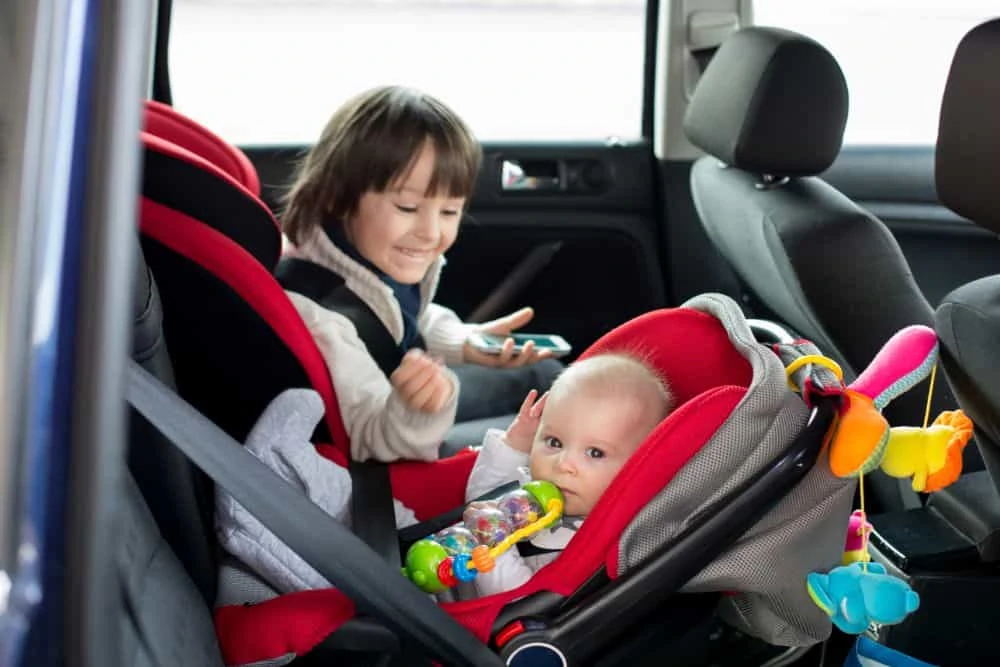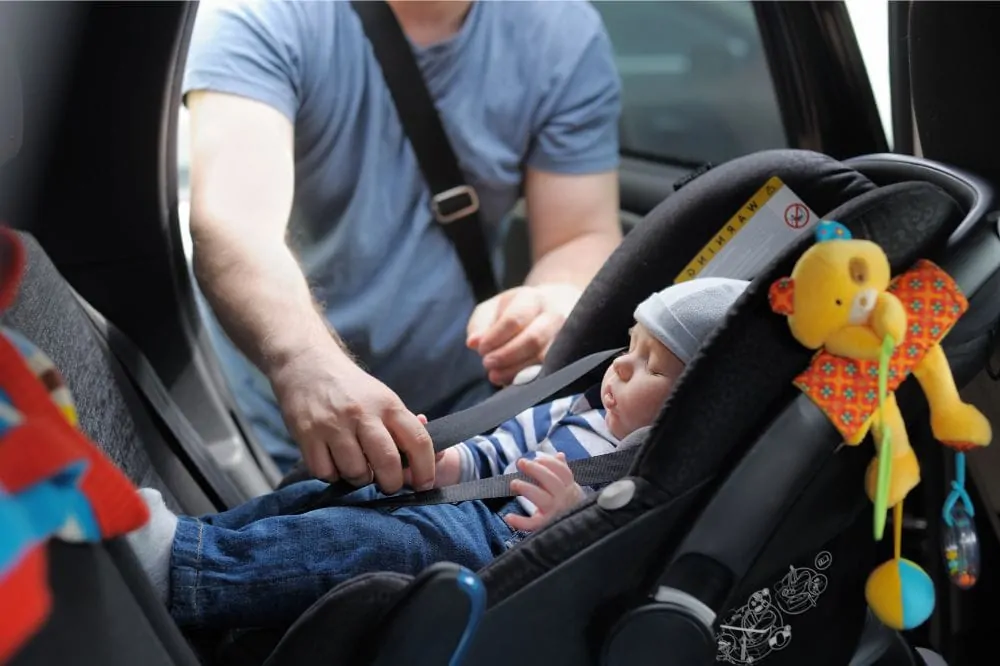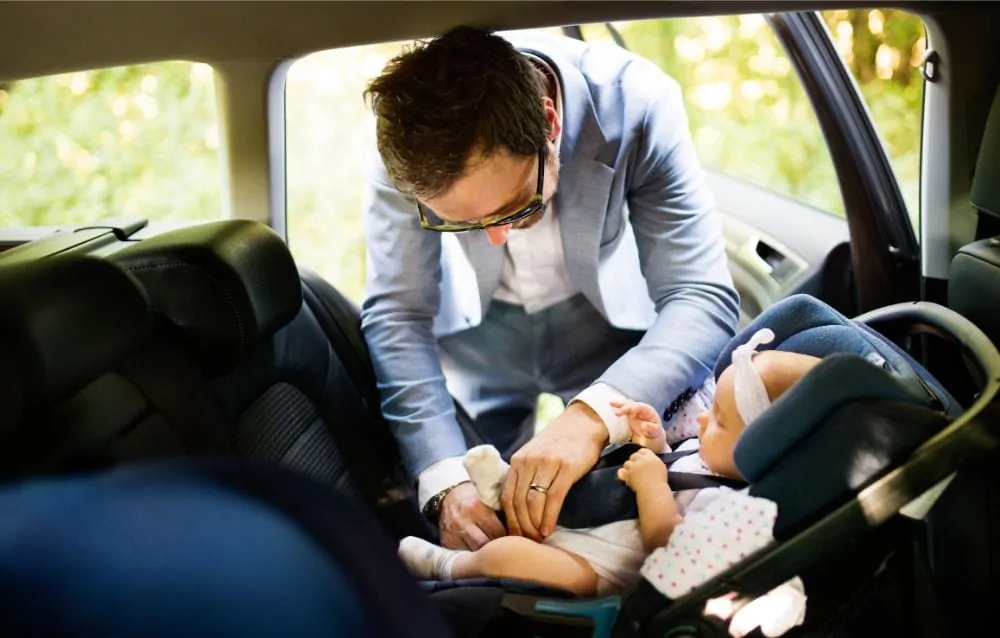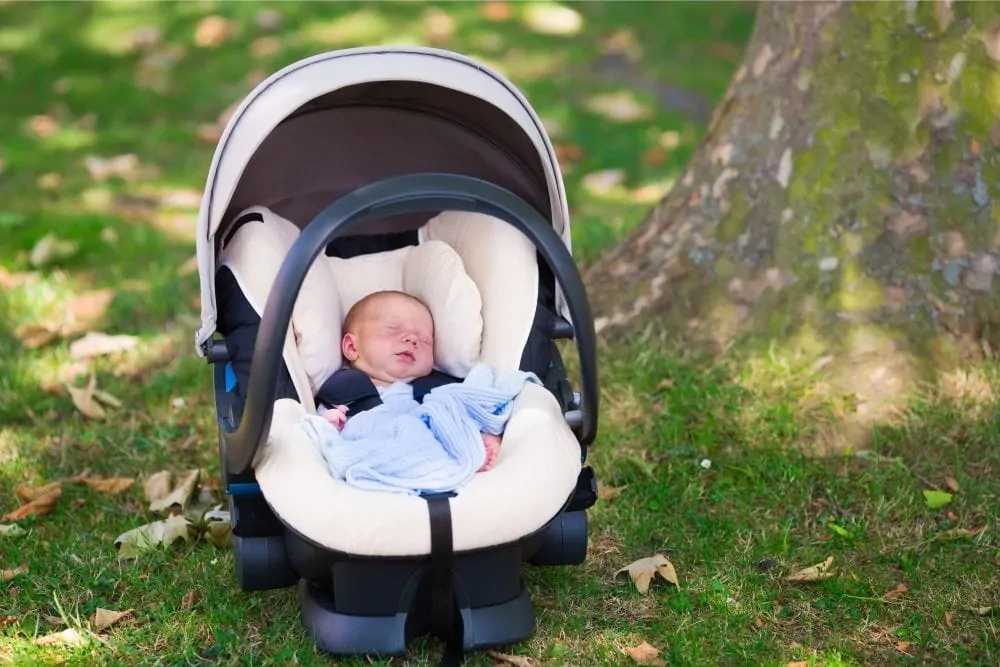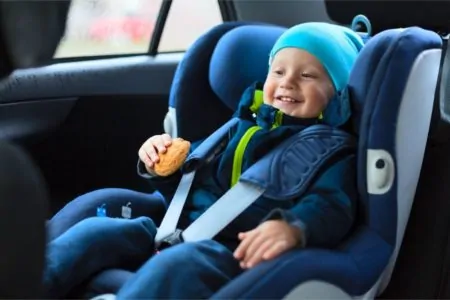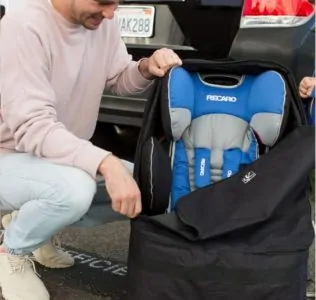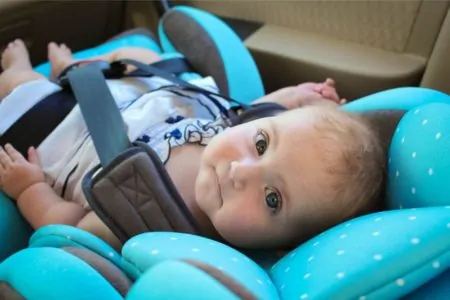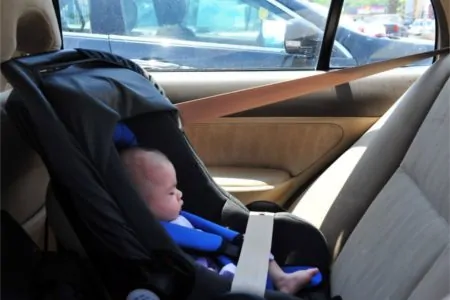Did you know that approximately 46 percent of car seats and boosters are misused, making them almost ineffective (1)?
Having the correct car seat protection is vital for the survival of your child if there is a crash. Unfortunately, it’s not enough to merely strap them in — knowing where to place the seat, how to properly buckle them, and when to upgrade is crucial.
We have all the information you’ll need to get up to speed on how to best protect your baby.
Key Takeaways
- Car seats are crucial for child safety in vehicles; they reduce the risk of injuries and fatalities in car accidents.
- Three types of car seats: rear-facing (for infants and toddlers), forward-facing (for children between 2 and 7 years old), and booster seats (for children between 8 and 12 years old).
- Choose a car seat that fits your vehicle, has a secure attachment system, and offers head support and side-impact protection; avoid outdated or recalled seats.
- Install car seats using either the LATCH system or seat belt system, and always follow the manufacturer’s instructions for proper installation.
Why You Should Use a Car Seat
No matter how good of a driver you are, crashes can happen. It’s not always your fault, so it’s essential to prepare. We’ve gathered some eye-opening statistics you need to read.
- No car seat: The Centers for Disease Control and Prevention (CDC) carried out a one-year study on children between birth to 12 years old. They discovered that 618,000 rode without a car seat or booster on at least one occasion.
- Fatalities: It’s been estimated that approximately 723 children, aged 12 years and under, died due to a car crash in 2016. Keep in mind that this figure includes those with and without car seats and boosters. Of those who were in a safety device, 35 percent were buckled up incorrectly or not at all.
- Injuries: Around 128,000 children between birth and 12 were injured in car crashes in 2016. This statistic also includes babies in, or without, proper car seats.
- No restraint: Another study estimated that in around 40 percent of the cases where the children were riding without a seat belt, the driver was unbelted as well.
Since 1975, the U.S. has put a lot of focus on decreasing the number of child car crash fatalities. Fortunately, the number of fatalities has declined, and in 2017, only 677 occurred (2). Even still, many of these deaths are completely preventable.
These statistics underscore the importance of placing children in car seats. As any mother knows, sitting in the front, listening to your baby crying is one of the hardest parts of the car journey. But by taking your little one out of the seat, you’re jeopardizing their life.
Between 1975 and 2010, an estimated 9,611 children under 5 years old were saved due to the usage of car seats and proper restraint systems (3).
Infants and toddlers are fragile — vulnerable to spinal and neck injuries. By investing in the right car seat and strapping them in correctly, you’re significantly decreasing their chances of injury.
Car Seat Types
The car seat you’d buy for an infant is a lot different than the one you’d buy for a 4-year-old. To give you an overview, here are the three available types.
1. Rear-Facing
Experts recommend rear-facing car seats for infants and toddlers (4). If you’re in a crash, the rear-facing car seat will distribute the force of the collision around your baby. They cradle the child and move with them, protecting the head and neck, and helping your child’s body slow down to a stop more gently.
Rather than an age limit, experts recommend you use a rear-facing seat until your little one reaches the weight and height limits of a convertible car seat.
The usual weight limit is 40 pounds. This will typically accommodate children up to the age of 3 years or so. Some have a weight limit of up to 50 pounds, which would still work for an average 4-year-old.
The height limit is typically determined by the distance between your baby’s head and the top of the seat. There should be at least a 1-inch clearance. Anything less usually means that it’s time for an upgrade. Always read your car seat manual for clarification, because each car seat has its own set of rules and limits.
There are three types of rear-facing car seats. These are:
1. Infant Car Seat
Infant car seats are fit for newborns and infants. They are small, generally portable seats only to be used rear-facing. Babies usually outgrow these seats around 25-35 pounds.
Once your little one exceeds the limits of the infant seat, you can change to a convertible seat or an all-in-one.
2. Convertible Car Seat
Convertible car seats allow you to change from rear-facing to forward-facing using a harness and tether. These accommodate larger babies than infant seats, so you can use them in a rear-facing position for longer.
3. All-In-One Car Seat
As the name suggests, all-in-one car seats can do it all. You can use them for your little one in a rear-facing position, then change to forward-facing when they’re ready. You can convert the all-in-one to a booster seat when your child outgrows the car seat forward-facing.
2. Forward-Facing
A forward-facing seat consists of the shell and seat, secured by a tether. Keeping your child secure is a five-point harness with a strap over each shoulder, around the hips, left and right, and one between the legs.
As with the infant car seat, there’s not a set age limit. The typical range is between 2 and 7 years (5).
To find out if your child is beginning to outgrow the forward-facing seat, check the weight and height limit. The five-point harness weight limit can fall anywhere between 40 and 90 pounds, depending on the manufacturer.
If the seat converts to a booster, verify the weight limit of that as well. Sometimes, the booster seat has a different weight capacity than the harness.
Check the height of the shoulders and head. Your little one’s ears should never be higher than the top of the seat. And the shoulders should always be lower than the harness strap slot.
There are also two types of forward-facing seats:
1. Convertible Car Seat
You can use these for your newborn or toddler as a rear-facing seat, then turn it once your little one is ready. Investing in a convertible car seat like this is an excellent idea if you’re planning on having another baby.
2. Combination Car Seat
A forward-facing combination seat still has a harness and tether for safety, but you can convert it into a booster once your child is big enough. Make sure you buy one with a high weight limit for both harness and booster.
3. All-In-One Car Seat
This car seat grows with your child and can be used rear-facing, forward-facing, and as a booster. You can convert the all-in-one to a booster seat when your child outgrows the car seat forward-facing.
3. Booster Seat
Booster seats are the next step after forward-facing.
They stay with your child until they’re big enough to use a seat belt without needing a lift.
You should keep your child in a booster seat until they measure 4 feet and 9 inches tall.
This is generally somewhere between 8 and 12 years of age.
There are two types of booster seats:
1. Booster With High Back
This type boosts the height as well as providing some head and neck support, and a built-in shoulder belt guide. It helps your child fit the seat belt, while still being comfortable. A benefit of high-back boosters is they give extra support for long car rides and traveling for children who tend to fall asleep in the car. They are less likely to slump over when they have the support of a high back. This is important because slumping over results in a poor belt fit, which could potentially injure your child in a crash. High back boosters are recommended for new booster riders, children who need extra support, and cars without headrests.
2. Backless Booster Seat
Backless booster seats are there to lift your child higher, so the seat belt fits properly. They come with belt guides to help keep the seat belt in place. Your child will need to use a backless booster seat in a seat position that has a headrest in order to protect their head a neck.
Stay In The Back
How to Find a Safe Car Seat
As you might’ve guessed, finding the perfect seat is essential. If you’re currently expecting, this is something to buy before the baby is delivered. The hospital may not let you leave unless you have your new arrival buckled up in a car seat — and with good reason (7).
What You Need to Look for
It can be stressful buying your first car seat — we all want to ensure our baby is safe. Between infant only, convertibles, and necessary features, some things are worth looking into — including:
- Opt for a convertible: As any mother knows, the first year passes quickly — in the blink of an eye, your newborn is a toddler. We recommend opting for a convertible car seat as opposed to an infant only. Then you’ll have one less thing to worry about for a couple of extra years.
- Check your car: Buying a car seat that doesn’t fit your vehicle is annoying. Prevent this by measuring how much room you have to spare in the back seat. This is crucial, particularly if you need more than one seat. Read your vehicle’s manual to see what other rules your car has for child restraints.
- Attachment system: Will you be using the seat belt or LATCH system to secure the seat? Most modern vehicles allow for LATCH (Lower Anchors and Tether for Children). Not all middle seats allow for this, so verify first.
- Harness: Make sure the buckle is easy to secure and undo, especially for non-caregivers. Verify that the shoulder straps are below shoulder level — they should come up and over the shoulders, rather than down. Check to see how easy the harness will be to adjust as your baby grows.
- Head support: Your newborn will likely require some extra head support — look for a seat with, or allowing for, inserts. Avoid using neck pillows, or inserts from another brand — these can potentially restrict your baby’s breathing and won’t be safe in an accident.
- Material: We recommend a seat suited with energy-absorbing foam because if there is a crash, it will reduce the impact’s force around your little one. We also recommend something easy to clean. Babies are mess-making experts, so thank us later for this one.
- Protection and comfort: Look for deep walls and barriers to the side and around the head to ensure protection from side impacts. Not all include this, so do your research.
- Registration: Make sure you register your car seat after buying it. Then you’ll receive alerts on recalls or updates.
- Fabric design: This isn’t a critical point, although, having something which looks good doesn’t hurt anyone. You’re likely to be looking at the seat daily, so finding one to match the car interior is a good idea.
What You Need to Avoid
Some car seats should be avoided. Check for these things before use.
- Outdated seat: The typical lifespan of a car seat is anywhere between six to ten years. You may be given a hand-me-down seat. If you can’t verify the age, don’t use it.
- No label: If there’s no label stating the manufacturing date or model number, don’t buy the seat. You won’t be able to check if it’s been recalled.
- Recalled seats: When the manufacturer decides to recall the seat, it means that something is wrong. Avoid purchasing or continuing to use a recalled seat. You can check with the manufacturer or call the National Highway Traffic Safety Administration.
- Has visible cracks: Visible cracks are likely to mean more damage underneath the hood. This reduces the safety of the seat, and you should steer away from such.
- No included instructions: If you buy a secondhand seat, or get a hand-me-down from a friend or family, make sure instructions are included. Every seat requires a different installation, so to be safe, instructions are a must-have.
- Missing parts: If the car seat you inherited from a friend is missing a piece or two, check that you can replace the components. If not, don’t use it.
- Has been in an accident: Car seats should not be used if they’ve been in a crash where the vehicle suffered damage (8).
Best Way to Install a Car Seat
When it comes to installing a car seat, there are two systems you can use — LATCH and seatbelt. Here are some brief instructions for each. However, read the included guidelines for your specific seat:
LATCH System
The LATCH system is comprised of built-in anchors in your vehicle, which you use to secure the car seat by attaching a strap with hooks. Most vehicles sold in the U.S. after 2003 have at least two sets of these in the backseat.
Here’s what you do:
- Attach the lower anchors: Locate the belted hooks on the car seat and attach each to the two lower anchors. If your baby is rear-facing, skip to the last step.
- Attach tether: Forward-facing seats have an additional belted hook at the top. Pull the tether over and attach it to the tether anchor sitting either on the back of the vehicle’s seat or on the floor behind it. Some rear-facing seats also have one — you’ll want to check the instructions and car manual.
- Check the seat: Grab the seat near the belt path and pull the seat side-to-side and front-to-back with the force of a firm handshake. It should not move more than an inch to any side.
Seat Belt System
If your car doesn’t have a LATCH system, or you cannot safely use it in the seating position your child is in, the seat belt works just as well. Here’s what you do:
- Scope out the seat belt path: Consult the instructions, and find the marked seat belt path on the car seat. It’s usually indicated with colored openings, which you pull the belt through.
- Pull the seat belt through: Feed the seat belt through the marked openings, and buckle it in.
- Switch retractor system: It’s essential to lock your seat belt to ensure the seat belt won’t loosen by slowly pulling the seat belt to its full length — listen for a click. Then gently feed it back into the retractor, feeling for a ratcheting motion. If nothing changes, refer to your vehicle’s owner manual — your car may have a button.
- Attach tether: If it’s a forward-facing seat, attach the tether to the hook on the back of the seat or car floor.
- Check the seat: Again, check the tightness of your installation by placing your hands at the belt path and moving the car seat side-to-side and front-to-back to ensure the car seat is secure. Remember, it shouldn’t budge more than an inch.
10 Safety Tips for Car Seats
It’s been estimated that almost half of all car seats are installed incorrectly, or misused. Below we’ve listed ten safety tips that will make sure you and your passengers are as safe as possible in your vehicle:
1. Everyone Should Buckle up
It’s not only your little one who should wear a seat belt. Everyone in the car must buckle up for several reasons.
For starters, it sets an excellent example for your child as they grow up. As parents, we should always be role models. How can you tell your 3-year-old to stay buckled when you sit freely?
Secondly, it’s for safety reasons. By not wearing a seat belt, you’re not only endangering yourself but all the passengers. When you’re in a crash, the force is so high that anything not secured becomes a missile — even you.
The same goes for the unbuckled person sitting in the backseat next to your baby. In a hard-impact crash, that person could crush your baby. So although you made sure to buckle up the little one, they could still get hurt due to the irresponsible actions of another passenger.
We know this sounds gruesome, but it’s vital to be aware of it. If the seat belt is uncomfortable, check your car manual to see if it can be adjusted.
2. Don’t Distract Yourself
Entertaining the baby, taking photos or videos, talking on the phone, or texting are all distractions. It’s essential you keep your eyes on the road, especially with precious cargo such as human lives.
It can be stressful sitting in the front and hearing your baby cry. There are some things you can do to help make your child’s journey more pleasurable. These are:
- Comfy baby: Ensure your baby is comfortable. Check that they’re not too hot or too cold, have enough head support, and no scratchy or pinching clothes.
- Bring entertainment: Take some favorite toys or music with you. Colors, lights, and sounds are perfect for distracting a fussy baby. Perhaps look for a musical car seat mirror, but only if it can be firmly attached with hardware so that it does not become a projectile in the event of a crash.
- Schedule your trip: If you’re going on a long outing, try to schedule it during your baby’s nap time or bedtime. It works every time I go on a long journey, and my little one sleeps through it all.
3. Always Use the Tether Strap
Once you turn your baby forward-facing, it’s vital to ensure the seat doesn’t whip forward in an accident. For this, we use the tether strap.
The tether strap sits on the top of the baby car seat. It’s the one you bring over the car’s back seat and secure in the anchor. The tether anchor is usually on the car’s back seat or on the floor behind it.
This will keep the car seat from whipping forward upon impact. It minimizes the potential injuries to your child’s spinal cord and neck. In tests, it showed that without tether attachment, the baby’s head could launch six inches further forward than with it.
Most cars produced after the year 2000 have tether hooks behind all three back seats. Double-check if you drive an SUV or minivan. All forward-facing car seats have tether straps, and some rear-facing also.
4. Place the Car Seat in the Middle
Placing the car seat in the middle position is statistically the safest place to install it. This is because for side-impact crashes, the child is further away from the potential point of impact on each side. But the most important factor in deciding where you should place your child is where you can safely install it. It is more important to install the car seat correctly than to have it in the middle.
If you have more than one passenger in the back seat, place the child that is the most vulnerable in the center position. This could vary depending on your situation. Contact a Child Passenger Safety Technician for assistance if you aren’t sure what the best setup is for your family.
Use the seatbelts if there aren’t any LATCH hooks on the middle seat.
5. Keep the Straps Snug
The straps are there for a reason — to keep your baby secure. With that said, many of us are, unfortunately, guilty of keeping them too loose. Toddlers and older children often complain of how tight it is — even when it’s not.
As you tighten the shoulder straps, you shouldn’t be able to pinch any slack from the straps at the shoulder. Also, verify that the chest clip sits at armpit level.
6. Remove Heavy Winter Clothes
Babies should stay warm during the winter, but don’t overdo it.
In the car seat, it’s important to remove heavy coats or thick clothing. Otherwise, it could prevent the harness from tightening enough. You don’t want to risk baby slipping out or being whipped back and forth.
Secondly, heavy clothing could restrict breathing, particularly in infants. Remove restrictive clothing and instead, use boots or a small blanket. Conversely, ensure your little one isn’t overheating — if you feel hot, they’re likely feeling the same.
Try layering your children’s clothing with long-sleeved shirts and a thin fleece jacket. Thin layers provide additional warmth without the bulk. Once your child is secure in the car, you can then place a blanket over them as well.
Editor's Note:
Kristen Gardiner, CPST7. Correct the Angle
Because infants can’t support their heads properly, it’s common that they flop forward. This isn’t safe as it could block the airways or injure the neck.
To prevent it, ensure the car seat sits at a 45-degree angle with the top tilting slightly backward. There should be a recline indicator on the side of your car seat to help you measure when your car seat is positioned at the correct angle. If you are having problems, you can use a rolled towel to lift one end to achieve this angle (if your car seat manual permits it).
8. Get the Installation Checked
Once your new car seat is installed, get it checked by a certified Child Passenger Safety Technician. They can verify if the installation is correct and give you additional helpful information.
Getting a pair of trained eyes to double-check gives you peace of mind, which can mean a world of difference. When it comes to car seat safety, assuming doesn’t cut it.
9. Don’t Jump the Gun on Booster Seats
Booster seats are the step before no seat at all and help properly position the seat belt so the seat belt can adequately protect your child in a crash. For your child to upgrade, they must show maturity. They shouldn’t lean over excessively, slouch, or play with the seat belt. If your child isn’t able to sit still in a booster seat, the seat belt can’t do its job to protect your child. The seat belt must be positioned properly.
Most kiddos don’t reach this stage until at least 6 years of age — some even later. Remember, your child should weigh at least 30 to 40 pounds before making the change.
You shouldn’t let them out of the booster seat until they’re ready either. The seat belt should sit right around the shoulder and low on the hips to minimize injuries. The 5-step-test gives the criteria to help you know when your child is ready to graduate from a booster seat.
10. Car Seats Expire After a Crash
Car seats expire after an accident. Following a moderate to severe crash, the seat goes in the trash (9). Even if there’s no visible damage, it’s still essential to change, since the seat’s effectiveness could be compromised. If you are ever unsure, contact your car seat manufacturer for further guidance.
Check with your insurance company. Some reimburse a new car seat if deemed necessary after a crash.
FAQs
Stay Safe
Car seats and boosters are a must for any child under 13 years. Which of the three main types of seats you’ll use depends upon your child’s weight and size. Children should sit rear-faced for as long as possible, or until they exceed the weight and height limit of the seat.
Remember to buy a car seat before your baby is born, and get the installation checked by an expert. Be a role model and buckle up every time you’re in a vehicle.
Remember, car seats expire — following an accident or after years of use — so avoid hand-me-downs and keep an eye on the dates.
We hope you found our car seat safety tips helpful. As parents ourselves, we want to help protect all the children out there!

